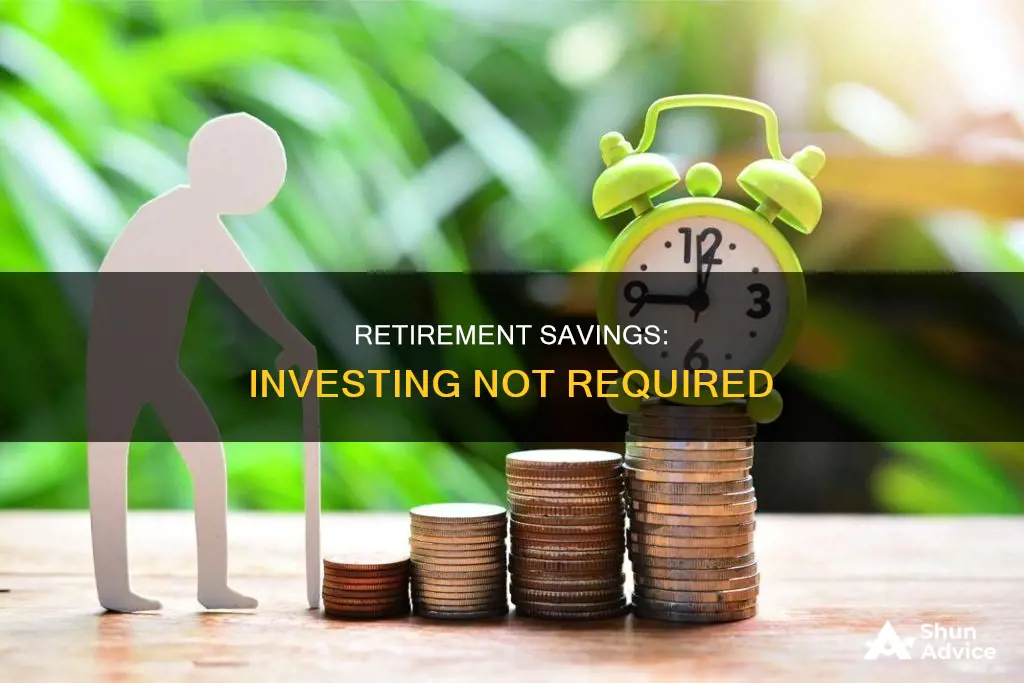
If you don't have access to an employer-sponsored retirement savings plan, there are still plenty of options to help you save for retirement. You can contribute to a Roth IRA, a traditional IRA, a taxable brokerage account, or a health savings account (HSA). You could also consider launching a profitable side hustle and opening a solo 401(k) or Simplified Employee Pension (SEP) IRA. These options offer varying levels of flexibility, tax advantages, and investment opportunities to help you build your retirement fund.
| Characteristics | Values |
|---|---|
| Type of Account | Individual Retirement Account (IRA) |
| Tax Treatment | Traditional IRA: Tax-deductible contributions, taxed withdrawals. Roth IRA: Taxed contributions, tax-free withdrawals. |
| Contribution Limits | Traditional/Roth IRA: $7,000 annually ($8,000 if 50 or older). |
| Eligibility | Roth IRA: Income and tax filing status eligibility requirements. Traditional IRA: No income limits. |
| Investment Options | Good growth stock mutual funds, exchange-traded funds (ETFs), real estate investment trusts (REITs), certificates of deposit (CDs), stocks, bonds, money market funds. |
| Other Options | Health Savings Account (HSA), Brokerage Account, Solo 401(k), Simplified Employee Pension (SEP) IRA, Small Business Ownership. |
What You'll Learn

Pay off high-interest debt
Paying off high-interest debt is a crucial step towards achieving financial security and a comfortable retirement. Here are some detailed instructions to help you tackle high-interest debt:
Identify High-Interest Debt
Start by identifying your high-interest debt. Credit cards are a common source of high-interest debt, often charging interest rates of 18% or more if you don't pay off your balance in full each month. Other types of debt, such as personal loans or certain types of mortgages, may also carry high-interest rates. Review your financial statements and calculate the interest rates for each debt to determine which ones are costing you the most.
Prioritize High-Interest Debt
Once you've identified your high-interest debt, prioritize paying it off. Make it a goal to pay off these debts as quickly as possible to minimize the amount of interest you pay over time. Create a debt repayment plan by listing your debts from highest to lowest interest rate.
Focus on One Debt at a Time
There are different strategies for tackling multiple debts. One effective approach is to focus on paying off one debt at a time. Allocate as much money as you can towards the debt with the highest interest rate while continuing to make minimum payments on your other debts. Once the first debt is paid off, move on to the next highest-interest debt and repeat the process. This method will help you make a noticeable dent in your debt and save on interest.
Consider Balance Transfers and Consolidation
If you have credit card debt, consider transferring your balances to a card with a lower interest rate or a promotional 0% interest rate for a set period. This can give you some breathing room and help you pay off the principal amount without accruing additional interest. Alternatively, you can explore debt consolidation loans, where you borrow enough money to pay off your high-interest debts and then focus on repaying that loan, ideally with a lower interest rate.
Create a Budget and Stick to It
Creating a budget is essential to help you stay on track with your debt repayment goals. Calculate your monthly income and expenses, including the minimum payments for all your debts. Look for areas where you can cut back on discretionary spending to free up more money for debt repayment.
Avoid Accumulating More Debt
While paying off your high-interest debt, avoid accumulating more debt. This means refraining from making new purchases with your credit cards or taking on additional loans. Instead, focus on using cash or debit cards for your purchases, and only spend what you can afford.
By following these steps, you can effectively tackle your high-interest debt and improve your financial situation. Paying off high-interest debt is a crucial step towards achieving financial freedom and a secure retirement, even without investing.
Investing: Hold or Fold?
You may want to see also

Open a health savings account
A health savings account (HSA) is a tax-friendly investment vehicle that can be used to save for retirement. HSAs are designed to help you pay for qualifying healthcare expenses, but they can also act as a powerful retirement savings tool if you let your balance compound over the years.
Eligibility
To be eligible to open an HSA, you must be enrolled in a high-deductible health plan (HDHP), which has a lower monthly premium and a higher deductible. This type of plan may not be suitable for everyone, as it assumes that you are relatively healthy and do not require frequent doctor visits.
Tax Benefits
HSAs offer a triple tax benefit. First, contributions to an HSA are tax-deductible, lowering your taxable income. Second, your earnings grow tax-free. You can invest your HSA funds, and any interest earned is not taxed. Third, you can make tax-free withdrawals from your HSA for qualified medical expenses at any age.
Contribution Limits
The contribution limits for HSAs are adjusted annually for inflation. In 2024, the limits are $4,150 for individuals and $8,300 for families. If you are 55 or older, you can make an additional "catch-up" contribution of $1,000 per year.
Non-Medical Withdrawals
While HSAs are primarily intended for medical expenses, you can also use the funds for non-medical expenses. However, there are tax implications for non-medical withdrawals. If you are under 65, you will be subject to a 20% tax penalty plus income tax on non-medical withdrawals. If you are 65 or older, you can make non-medical withdrawals without the 20% penalty, but you will still pay income tax on these distributions.
Investment Options
When choosing an HSA provider, consider the investment options available. Some providers offer mutual funds or index funds, while others may only allow you to put your money in a savings account with low interest. Shop around for a plan with high-quality, low-cost investment options.
Beneficiary Designation
When you open an HSA, you will be asked to designate a beneficiary for your funds upon your death. If you are married, it is generally advisable to choose your spouse as the beneficiary, as they can inherit the balance tax-free. However, you should periodically review your beneficiary designations, as life changes may alter your choices.
By understanding the features and benefits of HSAs, you can effectively use this tool to save for retirement while also enjoying the advantage of tax-deductible healthcare expenses.
Amazon Stock: Buy or Bye?
You may want to see also

Open a brokerage account
Opening a brokerage account is a straightforward process that can be completed in a matter of minutes. It is a tool that allows you to invest in the stock market and can be opened with online brokers or robo-advisors.
Determine the type of brokerage account you need:
You can choose between a traditional brokerage account and an individual retirement account (IRA). A traditional brokerage account offers more flexibility in terms of withdrawals but does not have tax advantages. On the other hand, an IRA offers tax benefits but has restrictions on withdrawals until retirement.
Compare the costs and incentives:
Review the fees and incentives offered by different brokerage firms. Consider the costs associated with trading options, mutual funds, ETFs, and bonds, as these may come with additional charges. Some brokers may offer incentives, such as bonuses for depositing a certain amount of money.
Consider the services and conveniences offered:
Look beyond pricing and explore the additional services provided by the brokerage firm. This includes access to research and third-party investment ratings, foreign trading capabilities, fractional shares, trading platforms, and convenience through local branch offices.
Decide on a brokerage firm:
Weigh the pros and cons of each brokerage firm based on their costs, fees, and the conveniences they offer. Consider your investment objectives and determine which broker is the best fit for your needs.
Fill out the new account application:
You can apply for a brokerage account online by providing personal information, such as your Social Security number, driver's license, employment status, annual income, and investment goals.
Fund your brokerage account:
You can link a checking or savings account to your brokerage account or use wire transfers, checks, or asset transfers from existing investments to fund your account.
Start researching investments:
Once your account is open and funded, it's time to start investing. Educate yourself on how to choose stocks, bonds, and funds wisely and create a well-diversified portfolio that aligns with your goals and risk tolerance.
By following these steps, you can open a brokerage account and start building your retirement savings without investing in traditional retirement plans.
Investing: A New National Pastime?
You may want to see also

Invest in real estate
Investing in real estate is a popular option for retirement savings, with nearly two-thirds of American households owning their homes. There are several ways to invest in real estate, each with its own benefits and drawbacks. Here are some options to consider:
Own Your Home
For most people, their home is their most valuable asset, even more so than their savings. If you own your home, you are already invested in real estate. You can utilise the equity in your home to generate retirement income or hedge against unknown risks. This can be done through downsizing, leveraging equity, or other means. It is important to note that this asset is not always considered a way to fund retirement, and there may be other options to explore.
Real Estate Investment Trusts (REITs)
A Real Estate Investment Trust (REIT) is a collection of properties or other real estate assets that are owned by multiple investors. It is similar to a mutual fund, but instead of investing in company stocks, you are investing in physical properties such as offices, apartments, and homes. REITs offer high diversification, easy entry, and the potential for strong returns. They also provide a hedge against inflation and can be a good way to diversify your investments away from the stock market. However, REITs may have burdensome taxes as dividends are taxed as ordinary income, and there may be limited control over the investment.
Buy, Improve, and Flip
This strategy involves purchasing a property, improving it through renovations or repairs, and then selling it for a profit. This can be a profitable venture, but it also carries the risk of losing money, especially if you lack the necessary skills, knowledge, or financial expertise. Successful flipping requires a combination of real estate knowledge, home improvement skills, access to cash, and financial acumen.
Purchase Residential Property and Rent it Out
This is one of the most common forms of real estate investing, where you buy a property and rent it out to long-term tenants. The key to success is finding tenants who are willing and able to pay enough rent to cover the mortgage, insurance, taxes, and maintenance costs. The location of the property and market rental rates are crucial factors to consider. While this strategy can provide above-average returns and a steady cash flow, it also requires significant upfront capital and can be time-consuming and stressful due to the responsibilities of managing the property and dealing with tenants.
Purchase Commercial Property
Investing in commercial real estate can be more profitable than residential real estate, but it also carries more risk, complexity, and requires a larger cash investment. Owning commercial property can be a way to increase your long-term wealth and monthly income, especially if you run your own business within that property.
Buy a Vacation Home and Rent it Out Part-Time
Investing in a vacation rental property can be lucrative, especially if you have the right home in a desirable location. You may be able to generate as much income from a few vacation renters as you would from a year-round tenant. Additionally, you may have the opportunity to enjoy the home yourself during certain periods. However, vacation rentals can be more expensive, and the seasonal nature of the business may limit your income-generating window, making it a riskier venture.
Crowdfunding
Crowdfunding is a newer way to invest in real estate, where multiple people contribute small amounts of money towards a specific property or project. This allows investors to participate in larger ventures without the need for a huge capital outlay or the hassle of managing the property themselves. It provides access to the real estate market with small investment amounts and the potential for strong returns. However, crowdfunding requires industry knowledge, and there is less liquidity compared to other investments.
SPACs: The New Investment Craze
You may want to see also

Open a small business
One way to save for retirement without investing is to open a small business. This can be done by either becoming a business owner or investing in an established company as a silent partner. Here are some things to consider when thinking about opening a small business:
Entrepreneurship
If you choose to become a business owner, you will need to consider the following:
- Business plan: Develop a detailed plan that outlines your business goals, target market, financial projections, and operating procedures. This will help you secure funding and navigate the challenges of starting a new business.
- Funding: Determine how you will fund your business venture. You can use your personal savings, take out a loan, or seek investors who believe in your vision.
- Legal and regulatory compliance: Ensure you understand the legal requirements and regulations for running a business, including licenses, permits, and tax obligations. Consult with legal and financial professionals to ensure compliance.
- Marketing and sales: Develop a marketing strategy to attract customers and generate sales. This may include online and offline promotional activities, networking, and building relationships with potential clients.
- Operations and management: Establish efficient business operations, including inventory management, customer service, and day-to-day tasks. Consider hiring employees or contractors to help with the workload as needed.
Investing in an Established Business
If you prefer to be an investor rather than an owner, you can consider the following:
- Finding opportunities: Research and identify established businesses that are seeking investors. Look for businesses with strong growth potential and a solid business model.
- Due diligence: Conduct thorough research and analysis before investing. Review financial statements, assess the management team's expertise, and evaluate the competitive landscape to ensure it is a worthwhile investment.
- Silent partnership: As a silent partner, you provide capital to the business but are not involved in its day-to-day operations. This allows you to benefit from the business's profits without the same level of time commitment and risk as an owner.
- Diversification: Consider investing in multiple small businesses to diversify your portfolio and reduce risk. This way, you increase the chances of having successful investments that can fund your retirement.
- Long-term commitment: Remember that investing in a small business is typically a long-term commitment. Be prepared to stay invested for several years to maximize your returns and achieve your retirement goals.
Student Debt Strategies: Investing to Reduce the Burden
You may want to see also
Frequently asked questions
There are several options for saving for retirement without a 401(k). You can contribute to a Roth IRA, a traditional IRA, a taxable brokerage account, or a health savings account (HSA). You could also launch a profitable side hustle and open a solo 401(k) or Simplified Employee Pension (SEP) IRA.
With a Roth IRA, you pay taxes upfront on your contributions, which then grow tax-free. This means that you can withdraw your savings in retirement without paying any additional tax. Additionally, there is no requirement to start withdrawing from the account at a certain age, as there is with a traditional IRA.
A solo 401(k) is a retirement plan for self-employed individuals with no employees. With a solo 401(k), you can contribute as both the employee and employer, with different contribution rules for each role. As an employee, you can contribute up to a certain percentage of your compensation, and as an employer, you can contribute up to a certain percentage of your earned income.
A Simplified Employee Pension (SEP) IRA is mainly used by small business owners who want to help their employees with retirement, but freelancers and self-employed individuals can also use this option. The advantage of a SEP IRA is its high contribution limit, but there is no Roth option. You cannot contribute more than 25% of your income or a set dollar amount, whichever is less.







